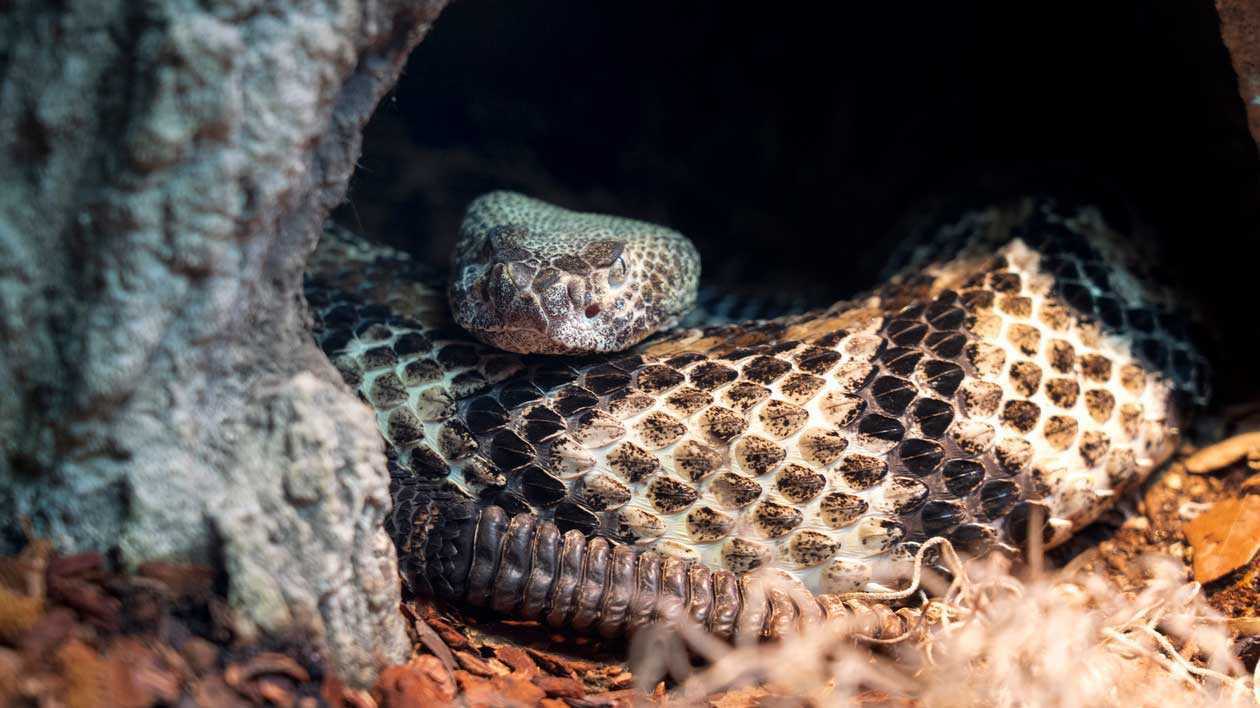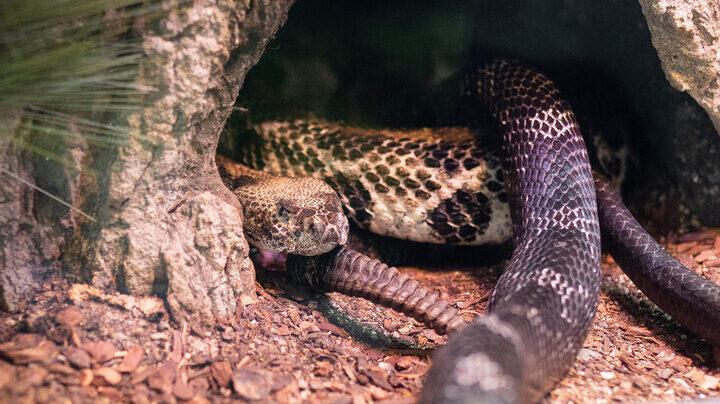Species Name: Crotalus horridus
Timber rattlesnakes are a species of pit viper widely distributed across the eastern United States, and are one of three species of venomous snakes native to Virginia.

Species Name: Crotalus horridus
Timber rattlesnakes are a species of pit viper widely distributed across the eastern United States, and are one of three species of venomous snakes native to Virginia.
Approximately 16-22 years.
Small rodents, birds, amphibians, and lizards.
Thickets, swamps, river floodplains, forests, mountains, and rural farms.
Eastern US from southern Minnesota eastward, and south to East Texas and North Florida.
Length: 30-60 inches, up to 7 feet long
Timber rattlesnakes are marked with dark brown or black chevron-shaped bands zig-zagging along their bodies, which are lighter gray, brown, or even pinkish. They also have a distinct yellow or rust-colored stripe running from their heads down their backs and ending at their tails.
Like all rattlesnakes, the timber rattlesnake possesses loose segments of keratin at the end of its tail, known as "rattles" or "buttons," which produce a noise when shaken to warn potential threats away. Juveniles are born with just one these rattles, and gain a new rattle each time it sheds its skin. They can also lose rattles through injury. Juveniles can shed 8 times within 5 years, while adults usually shed 1 to 2 times a year.
Diet
Young rattlesnakes mainly prey on small rodents while adult snakes consume larger prey like squirrels and rabbits. They also eat amphibians and other small reptiles.
Habitat
Timber rattlesnakes range across much of the eastern United States, though in Florida they are only found in the northern regions. They prefer habitats like lowland cane thickets, swamps, river floodplains, and pine forests, but can also be found in mountains and rural farming areas. They are not often seen in highly populated suburbs or urban areas.
Reproductive Behavior
Females reach sexual maturity after about 5 years and may wait 2 to 3 years between each clutch of eggs they lay. They are ovoviviparous, meaning embryos develop separately within unshelled amnions, which rupture either during or just after emerging from the female. They appear as though they give birth to live young, but unlike mammals, developing embryos receive nutrition through an egg yolk, not a placenta. Females give birth to anywhere from 3 to 13 snakelets at a time. Unlike many other animals, these snakes tend to give birth in September or October.
Seasonal Behavior
Timber rattlesnakes hibernate during the winter months and become more active by late spring. After emerging from hibernation, snakes will migrate, sometimes long distances from their dens, to forage, mate, and bask in warm temperatures.
Relationship With Humans
These snakes are generally docile, generally keeping to themselves but willing to bite when threatened. Bites from timber rattlesnakes are rare, but their venom can be lethal to humans and requires emergency attention.
Concerns
Populations across their range have been decreasing, likely due to habitat destruction and other human factors. Road construction has become a detriment and snakes commonly become roadkill when roads cross their migration trails.
One concern that conservationists are monitoring is snake fungal disease (SFD). Reports of snakes with fungal skin infections have seen a sharp rise. A fungus called Ophidiomyces ophidiicola has been identified in a large portion of the eastern United States, and some of the serious symptoms observed in snakes include skin ulcerations, abnormal molting, and even facial disfiguration that can lead to starvation and death. Research is ongoing to determine what impact environmental changes may have on the severity of SFD and how widespread the impacts are globally.
Celebrations
This species is not currently protected in southern states, but they are protected in several northern states and populations are monitored closely by researchers.

Duane
Duane's age is unknown, but he has been a resident at the Virginia Aquarium since 2014. He lives in an exhibit in our Coastal River Room with our eastern rat snake, Willy. Snakes like these can often be found hibernating and nesting together in their native habitats, which is why Duane and Willy don't mind being roommates.

Least Concern (LC)
A taxon is Least Concern (LC) when it has been evaluated against the Red List criteria and does not qualify for Critically Endangered, Endangered, Vulnerable, or Near Threatened.
IUCN Red List